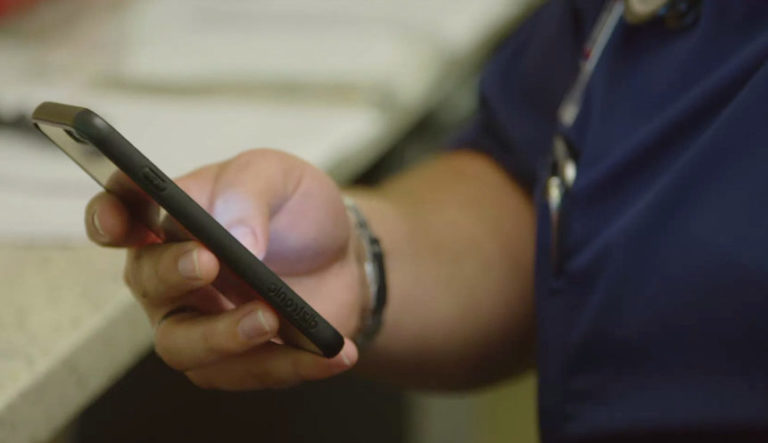Suffice it to say, physicians are busy. So busy, in fact, that physician burnout has become the new hot-ticket term of 2019—part of a bigger, broader category of workplace burnout that now has a designated spot on the WHO’s International Classification of Diseases.
Between rounds, procedures, clinic and the daily grind of practice management, it’s easy to see why. It’s also easy to understand why physicians are more resistant to emerging technologies at the hospital. In their view, it takes time to ramp up and use healthcare IT platforms—and physicians are stretched too thin as it is.
That is, unless they have access to technology that helps them focus on medicine in a more meaningful and efficient way. But even then, getting clinicians to use that technology can sometimes seem like an uphill battle.
That doesn’t mean that those technology investments aren’t worthwhile for doctors. It just means that engaging physicians to use them takes time—as well as a steadfast commitment to overcoming the barriers of any technology rollout, from personal barriers (“It’s a steep learning curve to use this, and I don’t have time for it.”) to organizational ones (“There’s no single policy for using this technology, so why should I?”).
According to an analysis by Gallup, for example, four key problems hold hospitals back from successfully engaging physicians:
- Not understanding physician pain points, and how to solve them.
- Not streamlining communication between doctors and administrators.
- Not involving physicians’ input in decisions regarding hospital administration.
- Not equipping physicians with opportunities to develop professionally.
But with the right mix of those elements, administrators can help shift the physician mindset of healthcare IT from being burdensome to beneficial. So if you’re struggling with physician adoption of your clinical communication and collaboration (CC&C) platform, start with these tips:
1. Talk in Their Terms
Above all, doctors want to spend time doctoring—talking with patients, considering interventions and exploring medical mysteries to make people’s lives better. While everyone is different, many physicians may not care as much about the brass tacks of operational efficiency and secure chat, so explaining the value of clinical communication and collaboration in those terms won’t pique their interests.
Instead, convey how the improved workflows as a result of the technology helps them get back to what they care about: patients and medicine. The MH-CURE® features that enable them to do this are ample … and worth bringing up:

But most of all, with MH-CURE, nurses can instantly and directly notify physicians when their patient is in need. A “Jane Smith is now 8 centimeters dilated and 90 percent effaced” text message, for example, gets sent immediately to the obstetrician—who can leave the clinic at the right time to deliver her patient’s healthy new baby.
2. Bring up Reimbursement
Deploying the right CC&C technology can also speed up reimbursements, thanks to faster workflows that more easily integrate clinical and operational processes. For example, a physician can more quickly forward information that may be needed for insurance preauthorization. That way, patients can get scheduled—and providers can get paid—faster.
Improved coordination also factors into payments. Take the Centers for Medicare & Medicaid Services’ Merit-based Incentive Payment System (MIPS), for example. The four measures of the MIPS program (quality, interoperability, improvement and cost) all link back to better care coordination. A CC&C tool that quickly enables physicians to: work smarter with other care team members, instantaneously transmit health information, and reduces wait times as a result not only supports their patients, it supports their bottom line, too.
3. Address Message Fatigue and Burnout
According to a recent survey among physicians at the Palo Alto Medical Foundation, more than 1 in 3 respondents said they had symptoms of burnout—and they were more likely to feel that way if they received high volumes of messages generated by their EHR platform. All told, physicians received an average of 243 of those messages weekly.
The fear of getting overwhelmed with messages is understandable—which is why it’s important to establish a culture of texting etiquette among all users. Through policy and practice, ensure that platform users only send physician-directed messages when a physician really needs to see them. Otherwise, consider other members of the care team who might be a more appropriate recipient. Thanks to MH-CURE’s Dynamic Care Team™ feature—which gives users a realtime view of everyone assigned to any given patient—senders can get their message to the right person (and only the right person).
4. Designate an Engagement Task Force
The best way to ensure your CC&C platform is meeting individual and organizational objectives is to designate a group of people who can oversee its high-level usage through CURE Analytics™. Doing so can help that group identify communication breakdowns, troubleshoot problems, build new workflows and evolve policy to match real-life practice.
For buy-in all around, include key stakeholders in the group—as well as a designated point person who represents each clinical service area. Aim to meet weekly or monthly to review policies, requests and new concerns as they come up.
By reviewing usage analytics, you can better understand barriers to physician adoption—and address them in real-time. It could be that doctors need more training overall, or on specific features. Or maybe they need more utility from the app by embedding additional tools from the InterApp Launch Points.
Whatever the case, the data is a great place to look for trends. And a task force of people who review that data is a great way to make the most of it.
Involving Physicians in the Process
Above all, one of the most important pieces of the physician engagement puzzle is getting doctors’ input: Consider it sacred to any technology roll-out. (According to Gallup’s research, it is.)
Whether you’re planning an enterprise-wide CC&C launch or would just like to boost an otherwise high adoption rate among physicians, making the clinician’s voice heard is a top priority. Usage data can expose lackluster adoption, but that’s just half the story. Only by talking with physician users, and asking them exactly what they need, can you understand the reasons why they do or don’t use the technology.
Then, and only then, can you move tech from being a burden that causes burnout to a benefit that solves it.





